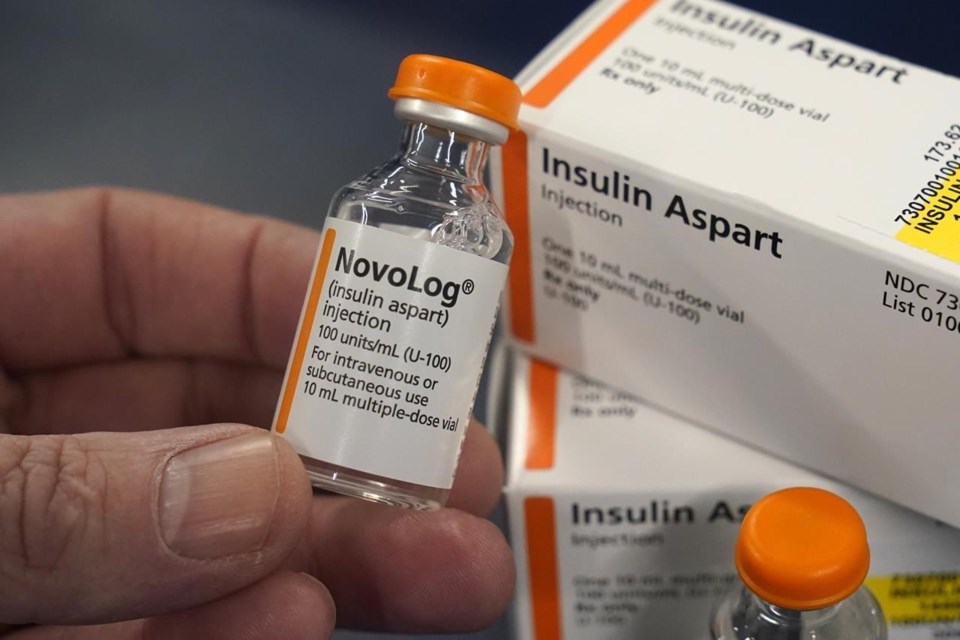Washington (AP) — Reining in the soaring prices of insulin has thus far been elusive in Congress, although Democrats say they'll try again — as part of their
The price of the 100-year-old drug has more than tripled in the last two decades, forcing the nation's diabetics to pay thousands of dollars a year for the life-saving medication. Democrats are considering capping the cost of that drug for at least some, although it’s unclear what the final proposal will look like and how many insulin users will get a price break.
Here’s a look at how insulin became so expensive and why it’s so difficult to bring the price of the drug down.
HOW MANY PEOPLE IN THE U.S. USE INSULIN AND FOR WHAT?
Roughly 8.4 million Americans use insulin, according to the American Diabetes Association. Not everyone who has diabetes needs insulin, but for those who do, it's an important medication. For more than 1 million of those people with type 1 diabetes, regular access to the medication is a necessity and they will die without it.
"People require insulin, it’s not an option and nobody should have to decide between life-sustaining medication or food and rent," said Dr. Robert Gabbay, the chief scientific and medical officer for the American Diabetes Association.
Insulin also helps control glucose levels for patients with other forms of diabetes. Some insulin users have rationed the drug because of its expense and risk numerous health complications as a result.
HOW EXPENSIVE IS INSULIN?
The price varies.
Some people on private insurance pay hundreds of dollars monthly for the drug. For most Medicare beneficiaries, the average out-of-pocket cost per insulin prescription was $54 in 2020 — an increase of nearly 40% since 2007, by the Kaiser Family Foundation found. Others live in one of 22 states where the copay for a 30-day supply has been capped between $25 to $100.
The cost has led some to use less insulin than their doctor prescribes or postpone paying for other medical care.
WHY IS INSULIN SO EXPENSIVE?
Only three manufacturers — Eli Lilly, Novo Nordisk and Sanofi — produce insulin, allowing those companies to control much of the market.
“They’ve been historically raising their list prices for their respective products in lockstep with one another,” Dr. Jing Luo, a professor of medicine at the University of Pittsburgh, said. “There hasn’t been a lot of pricing pressure.”
And making a generic drug for insulin hasn't been easy, with new manufacturers having to clear regulatory hurdles and questions over how a generic drug should be categorized, Luo added. A generic insulin is slated to come on the market in 2024 at no more than $30 a vial, which could drive down some of the price.
HOW DO DEMOCRATS PLAN TO CAP THE PRICE OF INSULIN?
That remains to be seen.
Senate Majority Leader Chuck Schumer has said some language that limits the price of insulin will be added to , but it's not clear what that price point will be and who all will be protected by that price cap.
Democrats had proposed a $35 monthly cap for those who get the drug through Medicare or private insurers as part of a bigger package that was derailed in the Senate. But it was left out of the scaled down package now headed for a congressional vote.
WHY IS THE COST OF INSULIN SO DIFFICULT TO CAP?
Capping the price of insulin will be very expensive.
Insulin is not only getting more expensive, but the number of people using it is also increasing.
A bipartisan bill proposed earlier this year that would cap insulin prices could cost about $23 billion over the next decade, according to estimates by the Congressional Budget Office. While the bill would reduce insulin costs for many consumers, it would drive up government costs and premiums charged by Medicare and private insurers, according to the office's analysis.
And that's one of the reasons why price caps can be controversial.
“If your health insurance company says, voluntarily, nobody who buys insulin in our plan will have to pay more than $25, the question is who is paying the balance of that?” Luo said. “That then means their cost will go up, which means they’ll raise premiums on everyone.”
Amanda Seitz, The Associated Press


